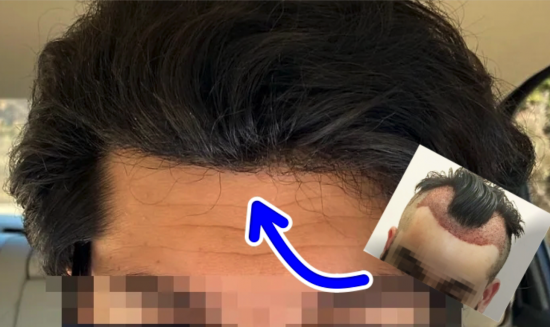Anyone who has spent time in this industry will know that if you can’t base your reputation on solid and consistent FUE results, then you need adapt to attract, this means usually you up the marketing and down the graft costs to be able to survive. We all need a USP or a unique selling point and this will be usually dependent upon what you are good at or not so good at. As the saying goes, behind large marketing campaigns you find small doctors, and what I mean by that is that due to a lack of real genuine and consistent results, many clinics will never be able to attract the punter by what happens in the surgery room, so in essence, fall back on marketing a special “technique” or indeed the tools themselves will be weaponised to attract, or for some, a low price that is not short on promises!
With everything from a 30 years guarantee on the hair transplant, similar to what you would expect on double glazing or white goods for the kitchen, to the best price or the best techniques, painless surgery and even freezing the grafts or using some magical holding solution, nothing really is off the table. What lacks in medical ability is certainly alive and well in other departments and the sad thing is, yes you guessed it, it works, if it didn’t, they wouldn’t do it.
So, with this in mind, how the graft is placed can become a minefield of conflicting information and even contradictory in its claims. Some of it is educational and valid and some marketing glitz, designed to bamboozle the reader and give them a sense that there is science in the claims and this transmits to a better result and therefore a benefit to the patient.
So, what do we use at BHR Clinic and why?
Dr.Bisanga and many top hair transplant practitioners will use pre-made slits. Don’t let the term “pre-made”, fool you to think of a pre-made sandwich or a suit or something inferior to “bespoke”, because in this sense it does not mean the lack or the inferiority that this term may imply.

It also has nothing to do with the harvesting of the grafts or the time they are out of the body, it is more concentrated on the timescales from the recipient sites being made to the placing of the graft into the sites.
Dr.Bisanga will once the donor has been numbed and grafts punched, will start then to numb the recipient area and cut the sites needed for surgery, or a good proportion of them in one go. This for him is critical in giving that flow and design he knows will be needed for the result both he and the patient are looking for.
Every site cut will be in light of the previous one and in view of the next one and will give the design, density, depth, and direction that will eventually bring about the final result. For Dr.Bisanga it is like laying out the chairs for the audience to sit on, it is easier to lay them all out to the designs you want prior to occupation and then fill them, rather than place one chair, one person, one chair, one person, one chair, one person..or as we say, rinse and repeat. So, the analogy may not be perfect in all detail but you get the point! Once Dr.Bisanga starts the sites he is in the zone and the momentum and all have kicked in and he knows where he wants that next graft to be and therefore the site also. He has magnification, his field of vision is small yet enhanced and he has that one after the other cut coming in rhythm, and really is like a precise machine in this, a constant flow without a continual stop/start. It is clean work, precise custom-made blades are used and hair angles and flows are re-created.
Once completed then the technicians will place the follicular units into these sites, their work is to handle the graft well, hold it above the bulb gently and place it into the sites with little to no trauma. The depth and direction etc is not down to them to create, they follow the path already made, and either with forceps or the KEEP implanter, these sites will be opened and the graft gently inserted.
This is our system, it works perfectly well and we have no incidence of pitting or ridging or indeed problematic patient healing. The opposite is true and we have also many cases of fast growth, it has been like many aspects, honed throughout the years but not substantially changed.

Step up stick and place..the site is cut and the graft is placed, the site is cut, the graft is placed, the site is cut and the..okay, you get the idea…The cycle changes, it is not cut, cut, cut, but cut and place, cut and place, stick and place in this instance. Some will prefer this, and also some top surgeons’s will prefer it, this is the two-stepped version of this technique, but for us, the setbacks are then you are interrupted from cutting the sites in that rhythm and knowing instinctively where the next one will be, to a kind of start-stop routine. Okay, it may work for some, good on them and this is not a criticism of the technique per se, but most, and certainly Dr.Bisanga and Dr.Kostis, will prefer the continuous flow of cutting the sites to get that design needed. A valid question here, however, is who is cutting the sites? Is the doctor entering the scene to cut them and place himself or is it he cuts and tech places, he cuts and tech places, and again? A question worth asking. So it is this constant back and forth or it is the doctor themself doing all? If you want this method then ask the doctor the logistics of it and how they will do this and what are the time implications also on it and especially for larger surgery? This is the two-step stick and place in a summary not exhaustive explanation.
One step stick and place, the implanter also cuts the site needed in the same action. A question for those who want this is are they happy for the technicians to do this? Remember the sites give the design, depth, direction, density, etc, you will need smaller ones for the immediate hairline and larger for the higher groupings, but need to be aware, it is probably a group of technicians doing this. Do they understand the intricacies needed? Will the left-handed tech cut the sites the same as a right-handed one? There is no design for them to follow, so it is CAYG, or cut as you go, so make sure you understand the implications, this is usually more tech-centric as a rule, find out the detail and see who does this. If doctor only, then the whole process is then doctor centric and not tech-centric, what are the implications on the time needed for this surgery to be completed, does it need more injections to keep the scalp numb as the site cutting time is largely extended?. One should understand all of the factors and implications behind a simple tagline of stick and place or whatever a clinic wishes to call it.
So, without giving an exhaustive, in-depth assessment of all of the techniques, I have sought to give a hint, a scintilla an overview of things to consider and ask your chosen clinic. As said, you may favour one technique over the other and that is fine, but it is good to ponder things that possibly you were not aware of, beyond the term of pre-made or stick and place and some of the implications.
Take care and thanks for reading, I do hope it was of interest and will be beneficial to you!
Steve
stephen@bhrclinic.com



